Paper Menu >>
Journal Menu >>
 J. Software Engineering & Applications, 2009, 2: 259-266 doi:10.4236/jsea.2009.24033 Published Online November 2009 (http://www.SciRP.org/journal/jsea) Copyright © 2009 SciRes JSEA 259 Nonparametric Demand Forecasting with Right Censored Observations Bin ZHANG1,2 ; Zhongsheng HUA2 1Institute for Economics and Lingnan College, Sun Yat-sen University, Guangzhou, China; 2School of Management, University of Science and Technology of China, Hefei, China. Email:1 bzhang3@mail.ustc.edu.cn Received July 17th, 2009; revised August 10th, 2009; accepted August 18th, 2009. ABSTRACT In a newsvendor inventory system, demand observations often get right censored when there are lost sales and no backordering. Demands for newsvendor-type products are often forecasted from censored observations. The Kap- lan-Meier product limit estimator is the well-known nonparametric method to deal with censored data, but it is unde- fined beyond the la rgest observation if it is censored. To add ress this shortfall, some completion methods are suggested in the literature. In th is paper, we propose two hypotheses to investigate estimation bia s of the product limit estimator, and provide three modified completion methods based on the proposed hypotheses. The proposed hypotheses are veri- fied and the proposed completion methods are compared with current nonparametric completion methods by simulation studies. Simulation results show that biases of the proposed completion methods are significantly smaller than that of those in the literatu re. Keywords: Forecasting, Demand, Censored, Nonparametric, Product Limit Estimator 1. Introduction In a newsvendor inventory system, a decision maker places an order before the selling season with stochastic demand. If too much is ordered, stock is left over at the end of the period, whereas if too little is ordered, sales are lost. The optimal order quantity is often set based on the well-known critical ratio [1], therefore demand ob- servations often get right censored when there are lost sales and no backordering. Because lost sales cannot be observed, the available sales data actually reflect the stock available for sale, rather than the true demand. Demands for newsvendor-type products are often fore- casted from censored observations. The problem of demand forecasting in the presence of stockouts is a well-known problem of handling censored observations, which was recognized by [2]. Approaches of handling censored observations can be divided into two classes: (1) parametric method, which often assumes that the observations come from specific theoretical dis- tribution and then estimate parameters of the assumed distribution by applying maximum likelihood estimation or some updating procedures [3]; This method is often used in density forecasting [4]; (2) nonparametric method, which is often established based on the product limit es- timator [5], and attempts to address the problem of the “undefined region” beyond the largest observation when it is censored [6]. Parametric methods for demand forecasting from cen- sored observations have been investigated in [7−14]. These works have been briefly reviewed in [15], and it has been indicated in [15] that it is difficult to determine the shape or family of demand distribution in advance when demand observations are censored. The product limit (PL) estimator is a nonparametric maximum likelihood estimator of a distribution function based on censored data. If the largest observation is cen- sored, the PL estimator is developed to estimate the left-hand side of demand distribution, but it is undefined for the right-hand side of distribution function. Under the assumption that there are more information besides the censored observations, Lau and Lau [3] and Zhang et al. [15] have investigated the problems of estimating the right-hand side of demand distributions. Without additional information besides the censored observations, truncation techniques or completion meth- ods are usually employed to define the whole distribution function. Truncation techniques are based on the data-driving rules, which include two common truncation rules: (1) truncating at the largest observation if it is censored, and (2) truncating at (n−l)th order statistics [6]. These truncation rules may intuitively appear to have good properties by avoiding problems in tail, but they will incur large bias because the location of the ignored  Nonparametric Demand Forecasting with Right Censored Observations 260 region is a random event. Completion methods aim to redefine the PL estimator beyond the largest observation if it is censored. We will briefly review nonparametric completion methods in the next section. In this paper, we propose two hypotheses to investi- gate estimation bias of the PL estimator, and provide three modified completion methods based on the pro- posed hypotheses. The proposed hypotheses are verified and the proposed completion methods are compared with current nonparametric completion methods in the litera- ture by simulation studies. The remainder of this paper is structured as follows. We briefly introduce the PL estimator and review current nonparametric completion methods suggested in the lit- erature. Then we propose two hypotheses to investigate estimation bias of the PL estimator, and provide three modified completion methods. We further verify the two hypotheses and compare the proposed completion meth- ods with current nonparametric completion methods by simulation studies. The paper ends with some concluding remarks. 2. Nonparametric Completion Methods In this section, we first introduce the PL estimator in the context of an inventory system, and then we review cur- rent nonparametric completion methods for the PL esti- mator suggested in the literature. 2.1 Product Limit Estimator Let i X , , be iid (independent identi- cally-distributed) demand from distribution F, and in- ventory level , be iid from distribution G. It is often to assume that both F and G are continuous and defined on the interval . In an inventory sys- tem, demand 1, 2,,i i Y1, 2i i n n, , 0, X is censored on the right by the avail- able inventory level , and we observe i Yi Z min , i XY ii and ii I XY , , where 1, 2,,in I stands for the indicator function, and i indicates whether demand observation i Z is censored (0 i ) or not (1 i ). Kaplan and Meier [5] introduced the PL estimator for the survival function , which is esti- mated as follows: 1St Ft : : 1 ˆ11 in I Zt nin i St ni (1) where :in Z denotes the ith ordered observation among all i Z , and :in corresponds to :in Z . From the above definition, it is observed that the PL estimator is undefined beyond the largest observation, i.e., for and :nn tZ:0 nn . 2.2 Review of Current Completion Methods To overcome the shortfall of the PL estimator that it is undefined beyond the largest observation, some comple- tion methods are suggested in the literature. Efron [16] introduced the notion of self-consistency, i.e., ˆE St 0 , for . (2) :nn tZ Gill [17] defined the survival function by : : :1 ˆ11 1 in I Zt in i ni n Gn n St for (3) :nn tZ Chen and Phadia [18] modified it as : 1: :1 11 1 in I ˆ Zt in ni cni n Cn St for(4) :nn tZ where 0, 1 2 Ftd c ˆ E is determined by minimizing the mean squared error loss 2 00 ˆ FtFtEStSt dSt (5) Clearly, the extreme values of scalar c yield Efron’s and Gill’s versions, respectively. Besides the above three constant completion methods, there are two curve completion methods suggested in the literature. Brown et al [19] suggested an exponential completion method as follows: ˆ B t e B St , for . (6) :nn tZ The parameter B is set by solving : : ˆ B nn Z nn SZ e , where :nn nn Z : 0, 0 limZ . Let ()i Z , , de- note the m ordered uncensored demand observations, the remaining 1,im nm observations are censored ones. Moeschberger and Klein [20] attempted to complete ˆ St by a two-parameter Weibull function as follows: ˆM Stk Mt e , for (7) :nn tZ The two parameters M and k in Equation (7) are de- termined by solving k Mm t m SZ e ˆ and 1 k Mm t e 1 ˆm SZ. When a completion method is used, the bias of ˆ St, ˆ B t EStSt , is entirely determined by the completion method [21]. For a completion method, it is clear that the “undefined region” has the most contribu- tion to the bias of the PL estimator. One might think that this region could be in some sense ignored, as it is sug- Copyright © 2009 SciRes JSEA 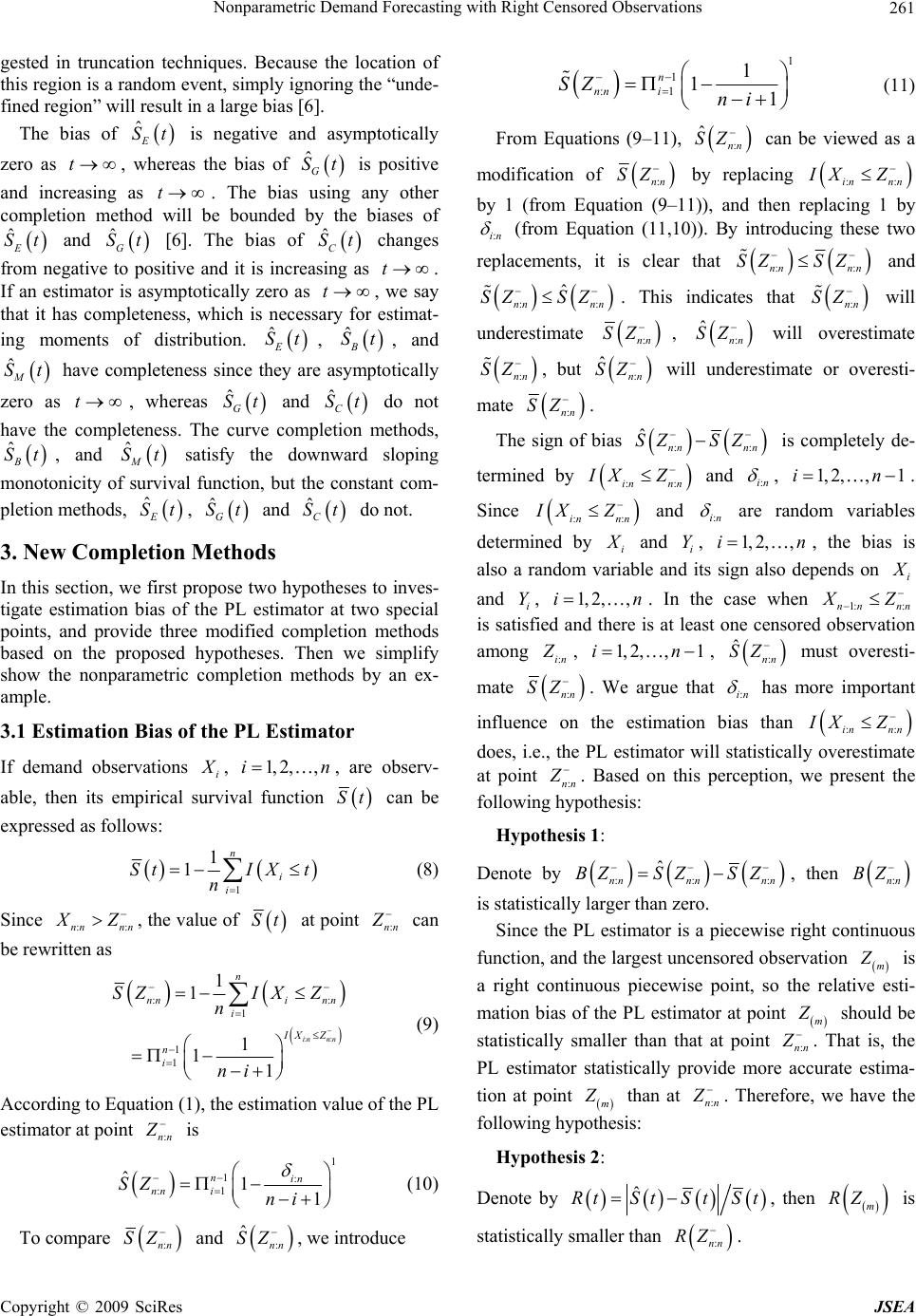 Nonparametric Demand Forecasting with Right Censored Observations 261 gested in truncation techniques. Because the location of this region is a random event, simply ignoring the “unde- fined region” will result in a large bias [6]. The bias of is negative and asymptotically zero as , whereas the bias of ˆE St t ˆG St ˆC S t St is positive and increasing as . The bias using any other completion method will be bounded by the biases of and [6]. The bias of changes from negative to positive and it is increasing as . If an estimator is asymptotically zero as , we say that it has completeness, which is necessary for estimat- ing moments of distribution. , t t ˆE St ˆG S t t ˆE t ˆB S, and ˆM St ˆB St have completeness since they are asymptotically zero as t, whereas and do not have the completeness. The curve completion methods, , and t ˆG S t ˆC S ˆM St ˆE St satisfy the downward sloping monotonicity of survival function, but the constant com- pletion methods, , ˆG St and do not. ˆC St 3. New Completion Methods In this section, we first propose two hypotheses to inves- tigate estimation bias of the PL estimator at two special points, and provide three modified completion methods based on the proposed hypotheses. Then we simplify show the nonparametric completion methods by an ex- ample. 3.1 Estimation Bias of the PL Estimator If demand observations i X , , are observ- able, then its empirical survival function 1, 2,,i n St can be expressed as follows: 1 1 1 n i i StIX t n : (8) Since :nn nn X Z , the value of St at point :nn Z can be rewritten as :: :: 1 1 1 1 1 1 11 in nn n nni nn i IX Z n i SZIX Z n ni (9) According to Equation (1), the estimation value of the PL estimator at point :nn Z is 1 1: :1 ˆ11 nin nn i SZ ni (10) To compare :nn SZ 1 1 :1 1 11 n nn i SZ ni (11) From Equations (9–11), can be viewed as a modification of : ˆnn SZ :nn SZ by replacing by 1 (from Equation (9–11)), and then replacing 1 by ::in nn IX Z :in (from Equation (11,10)). By introducing these two replacements, it is clear that ::nn nn SZ SZ and : ˆ nn nn SZ : SZ . This indicates that will underestimate :nn SZ :nn SZ , will overestimate : ˆnn SZ :nn SZ , but : ˆnn SZ will underestimate or overesti- mate :nn SZ . The sign of bias : ˆnn nn SZ SZ : is completely de- termined by ::in nn IX Z and :in , . Since 1, 2,,1in ::nn Z in IX and :in are random variables determined by i X and , , the bias is also a random variable and its sign also depends on i Y1, 2,i,n i X and , i Y1, 2,,in . In the case when 1: :nn nn X Z is satisfied and there is at least one censored observation among :in Z , 1, 2,,1in , must overesti- mate :nn SZ ˆ :nn SZ . We argue that :in has more important influence on the estimation bias than does, i.e., the PL estimator will statistically overestimate at point ::in nn IX Z :nn Z . Based on this perception, we present the following hypothesis: Hypothesis 1: Denote by :: ˆ nnnn nn BZSZ SZ : , then :nn BZ is statistically larger than zero. Since the PL estimator is a piecewise right continuous function, and the largest uncensored observation m Z is a right continuous piecewise point, so the relative esti- mation bias of the PL estimator at point m Z should be statistically smaller than that at point :nn Z . That is, the PL estimator statistically provide more accurate estima- tion at point m Z than at :nn Z . Therefore, we have the following hypothesis: Hypothesis 2: Denote by ˆ RtStStSt , then m RZ is statistically smaller than :nn RZ and , we introduce : ˆnn SZ . Copyright © 2009 SciRes JSEA 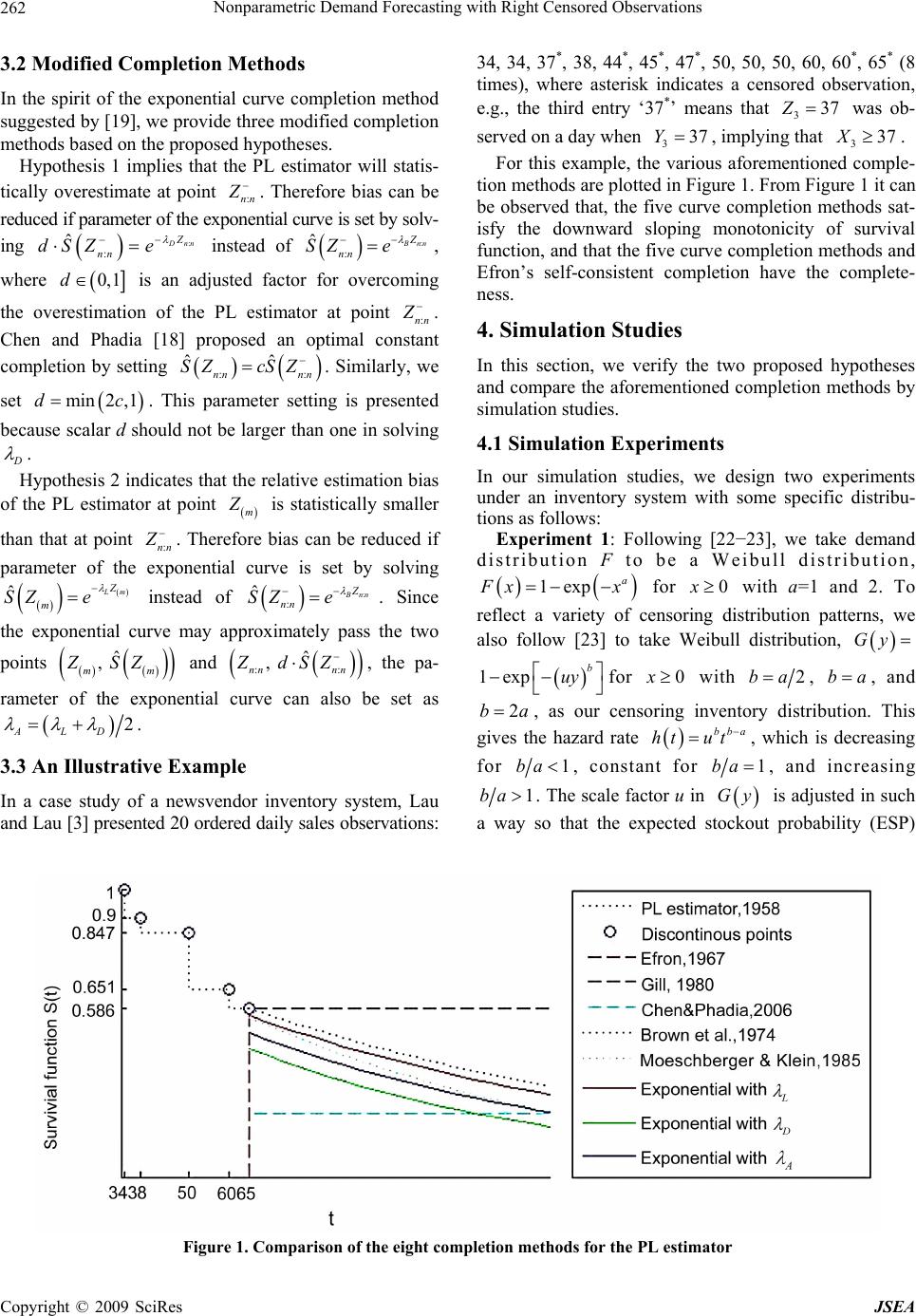 Nonparametric Demand Forecasting with Right Censored Observations Copyright © 2009 SciRes JSEA 262 34, 34, 37*, 38, 44*, 45*, 47*, 50, 50, 50, 60, 60*, 65* (8 times), where asterisk indicates a censored observation, e.g., the third entry ‘37*’ means that was ob- served on a day when 337Z 337Y , implying that . 337X 3.2 Modified Completion Methods In the spirit of the exponential curve completion method suggested by [19], we provide three modified completion methods based on the proposed hypotheses. For this example, the various aforementioned comple- tion methods are plotted in Figure 1. From Figure 1 it can be observed that, the five curve completion methods sat- isfy the downward sloping monotonicity of survival function, and that the five curve completion methods and Efron’s self-consistent completion have the complete- ness. Hypothesis 1 implies that the PL estimator will statis- tically overestimate at point :nn Z . Therefore bias can be reduced if parameter of the exponential curve is set by solv- ing : : ˆ D nn Z nn dSZ e instead of : : ˆ B nn Z nn SZ e , where 0,1d is an adjusted factor for overcoming the overestimation of the PL estimator at point :nn Z . Chen and Phadia [18] proposed an optimal constant completion by setting . Similarly, we set . This parameter setting is presented because scalar d should not be larger than one in solving : ˆ nn : ˆ nn Z SZ min2 ,1dc cS D . 4. Simulation Studies In this section, we verify the two proposed hypotheses and compare the aforementioned completion methods by simulation studies. 4.1 Simulation Experiments In our simulation studies, we design two experiments under an inventory system with some specific distribu- tions as follows: Hypothesis 2 indicates that the relative estimation bias of the PL estimator at point m Z is statistically smaller than that at point :nn Z . Therefore bias can be reduced if parameter of the exponential curve is set by solving instead of ˆLm Z m SZ e : : ˆ B nn Z nn SZ e . Since the exponential curve may approximately pass the two points and ˆ , m ZS m Z :: ˆ , nn ZdSZ nn , the pa- rameter of the exponential curve can also be set as 2 ALD . Experiment 1: Following [22−23], we take demand distribution F to be a Weibull distribution, 1exp a F xx for with a=1 and 2. To reflect a variety of censoring distribution patterns, we also follow [23] to take Weibull distribution, 0x Gy 1exp b uy for with 0x2ba, ba , and 2ba , as our censoring inventory distribution. This gives the hazard rate bb ut a ht , which is decreasing for 1ba , constant for 1ba, and increasing 1ba. The scale factor u in is adjusted in such a way so that the expected stockout probability (ESP) Gy 3.3 An Illustrative Example In a case study of a newsvendor inventory system, Lau and Lau [3] presented 20 ordered daily sales observations: Figure 1. Comparison of the eight completion methods for the PL estimator  Nonparametric Demand Forecasting with Right Censored Observations 263 Table 1. Statistical results of :nn BZ in Experiment 1 b/a =0.5 b/a =1 b/a =2 a=1 a=2 a=1 a=2 a=1 a=2 Mean of :nn BZ 0.0082 0.0102 0.0269 0.0259 0.0300 0.0312 Std. Dev. of :nn BZ 0.0667 0.0681 0.1075 0.1098 0.1487 0.1511 Lower 0.0041 0.0060 0.0202 0.0191 0.0208 0.0218 95% C.I. of :nn BZ Upper 0.01230.01450.0335 0.03270.0392 0.0406 Table 2. Statistical results of :nn BZ in Experiment 2 ESP =1/3 ESP =1/2 ESP =2/3 1 2 1 2 1 2 Mean of :nn BZ 0.0758 0.0893 0.1637 0.1839 0.2758 0.3144 Std. Dev. of :nn BZ 0.0607 0.0705 0.1053 0.1181 0.1419 0.1464 Lower 0.07200.0849 0.1572 0.1766 0.2670 0.3053 95% C.I. of :nn BZ Upper 0.0796 0.0936 0.1703 0.1912 0.2846 0.3235 is 1/3, 1/2, or 2/3. These values thus completely specify the hazard rate. The reader is referred to [23] for further details. This experiment is applied for investigating the case when hazard rate is decreasing, constant or increas- ing. Experiment 2: Analogous to [8], we express the rela- tion between demand X and sales Z by writing sales as a random proportion of demand, i.e., iii Z WX 1 i W , where is a random variable taking values on the interval [0.5,1]. For periods with no stockout, , and there- fore sales and demand are equal; for periods in which a stockout has occurred, sales will be less than demand with . We assume that stockouts occur in each period (independently) with probability ESP and when a stockout occurs, sales i W 1 i W i Z is a random (uniformly dis- tributed) proportion of demand i X . In our case studies, we take F to be a lognormal distribution with location parameter 4, and shape parameter 1 and 2, and we also set ESP=1/3, 1/2, and 2/3. This experiment is de- signed for investigating the case when hazard rate changes from increasing to decreasing. In the above two experiments, we have four different cases in terms of hazard rate: decreasing, constant, in- creasing, and changing from increasing to decreasing. In comparison with Experiment 1, Experiment 2 makes an additional assumption on the relation between demand and sales, i.e., sales is a random (uniformly distributed) proportion of demand. Considering the combination of the parameters in the above two experiments, under each of four cases of haz- ard rate, we have 6 different combinations of the pa- rameters. Under each parameters’ combination, we set the number of observations n=20, and randomly generate 1000 simulation runs. To ensure the applicability of the completion method suggested by Moeschberger and Klein [20], the number of uncensored observations in each simulation run is restricted to be larger than 3. For the convenience of comparison, the largest observation in each simulation run is restricted to be a censored one. 4.2 Hypotheses Verification Under each of four cases of hazard rate, we calculate :nn BZ under 1000 simulation runs for verifying Hy- pothesis 1. Statistical results of :nn BZ are reported in Tables 1 and 2. In these tables, 95% C.I. is short for 95% confidence level. Results shown in Tables 1 and 2 verify Hypothesis 1, i.e., the PL estimator statistically overestimates at point :nn Z . Table 1 also illustrates that increases with the increase of b/a, this implies that the estimation bias of the case with increasing hazard rate is larger than that of the case with decreasing hazard case. Table 2 also illustrates that :nn BZ :nn BZ increases as the expected stockout probability increases. To verify the correctness of Hypothesis 2, we calculate :nn RZ and m RZ under each of four cases of hazard Copyright © 2009 SciRes JSEA 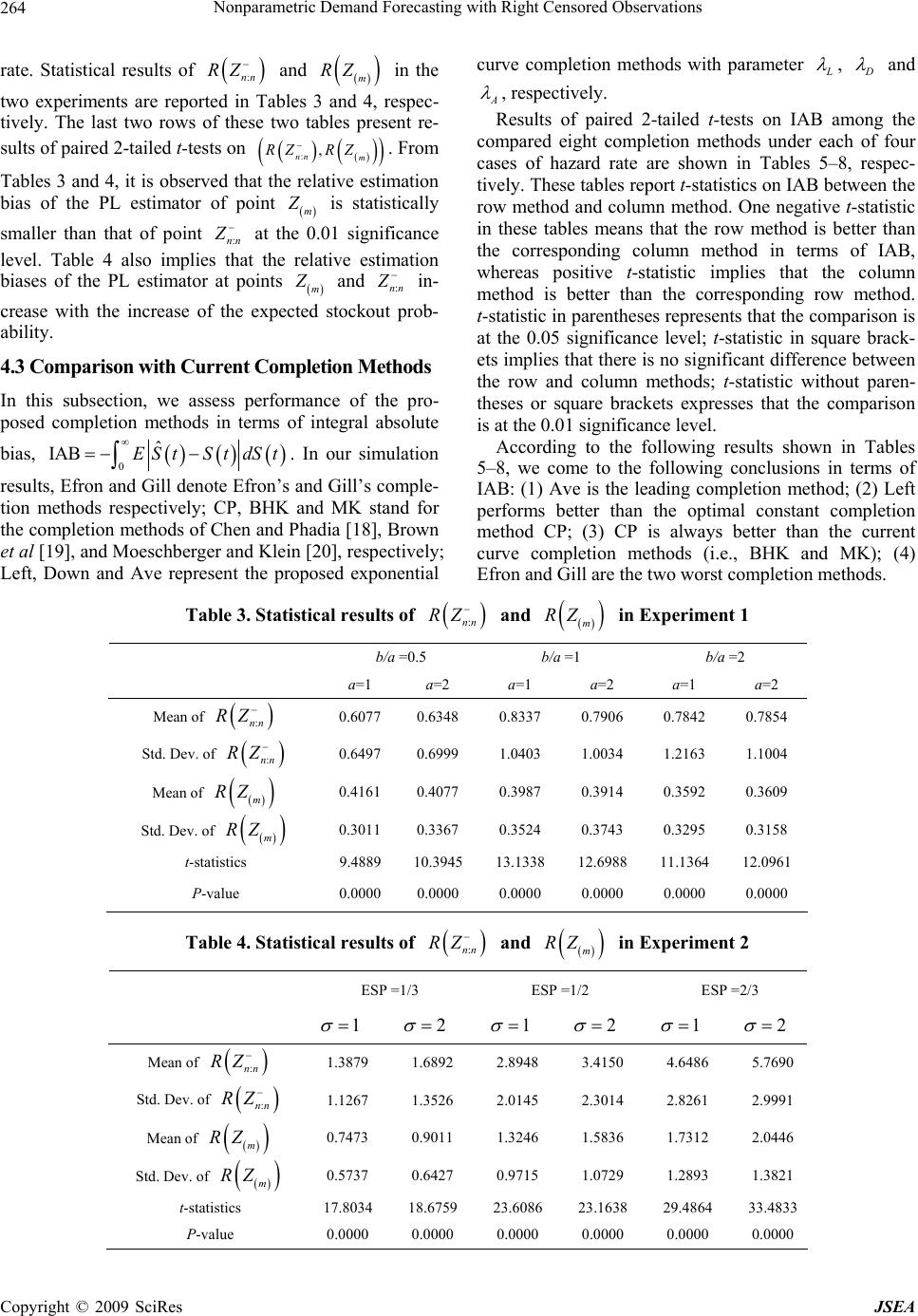 Nonparametric Demand Forecasting with Right Censored Observations 264 rate. Statistical results of :nn RZ and in the two experiments are reported in Tables 3 and 4, respec- tively. The last two rows of these two tables present re- sults of paired 2-tailed t-tests on m RZ :nn RZ m ,m RZ . From Tables 3 and 4, it is observed that the relative estimation bias of the PL estimator of point Z is statistically smaller than that of point :nn Z at the 0.01 significance level. Table 4 also implies that the relative estimation biases of the PL estimator at points m Z and :nn Z in- crease with the increase of the expected stockout prob- ability. 4.3 Comparison with Current Completion Methods In this subsection, we assess performance of the pro- posed completion methods in terms of integral absolute bias, dS t 0 ˆ IAB ES t S t. In our simulation results, Efron and Gill denote Efron’s and Gill’s comple- tion methods respectively; CP, BHK and MK stand for the completion methods of Chen and Phadia [18], Brown et al [19], and Moeschberger and Klein [20], respectively; Left, Down and Ave represent the proposed exponential curve completion methods with parameter L , D and A , respectively. Results of paired 2-tailed t-tests on IAB among the compared eight completion methods under each of four cases of hazard rate are shown in Tables 5–8, respec- tively. These tables report t-statistics on IAB between the row method and column method. One negative t-statistic in these tables means that the row method is better than the corresponding column method in terms of IAB, whereas positive t-statistic implies that the column method is better than the corresponding row method. t-statistic in parentheses represents that the comparison is at the 0.05 significance level; t-statistic in square brack- ets implies that there is no significant difference between the row and column methods; t-statistic without paren- theses or square brackets expresses that the comparison is at the 0.01 significance level. According to the following results shown in Tables 5–8, we come to the following conclusions in terms of IAB: (1) Ave is the leading completion method; (2) Left performs better than the optimal constant completion method CP; (3) CP is always better than the current curve completion methods (i.e., BHK and MK); (4) Efron and Gill are the two worst completion methods. Table 3. Statistical results of :nn RZ and m RZ in Experiment 1 b/a =0.5 b/a =1 b/a =2 a=1 a=2 a=1 a=2 a=1 a=2 Mean of :nn RZ 0.6077 0.6348 0.8337 0.7906 0.7842 0.7854 Std. Dev. of :nn RZ 0.6497 0.6999 1.0403 1.0034 1.2163 1.1004 Mean of m RZ 0.4161 0.4077 0.3987 0.3914 0.3592 0.3609 Std. Dev. of m RZ 0.3011 0.3367 0.3524 0.3743 0.3295 0.3158 t-statistics 9.4889 10.3945 13.1338 12.6988 11.1364 12.0961 P-value 0.0000 0.0000 0.0000 0.0000 0.0000 0.0000 Table 4. Statistical results of :nn RZ and m RZ in Experiment 2 ESP =1/3 ESP =1/2 ESP =2/3 1 2 1 2 1 2 Mean of :nn RZ 1.38791.68922.89483.41504.6486 5.7690 Std. Dev. of :nn m RZ RZ 1.12671.35262.01452.30142.8261 2.9991 Mean of 0.74730.90111.32461.58361.7312 2.0446 Std. Dev. of m RZ 0.57370.64270.97151.07291.2893 1.3821 t-statistics 17.803418.675923.608623.163829.4864 33.4833 P-value 0.00000.00000.00000.00000.0000 0.0000 Copyright © 2009 SciRes JSEA 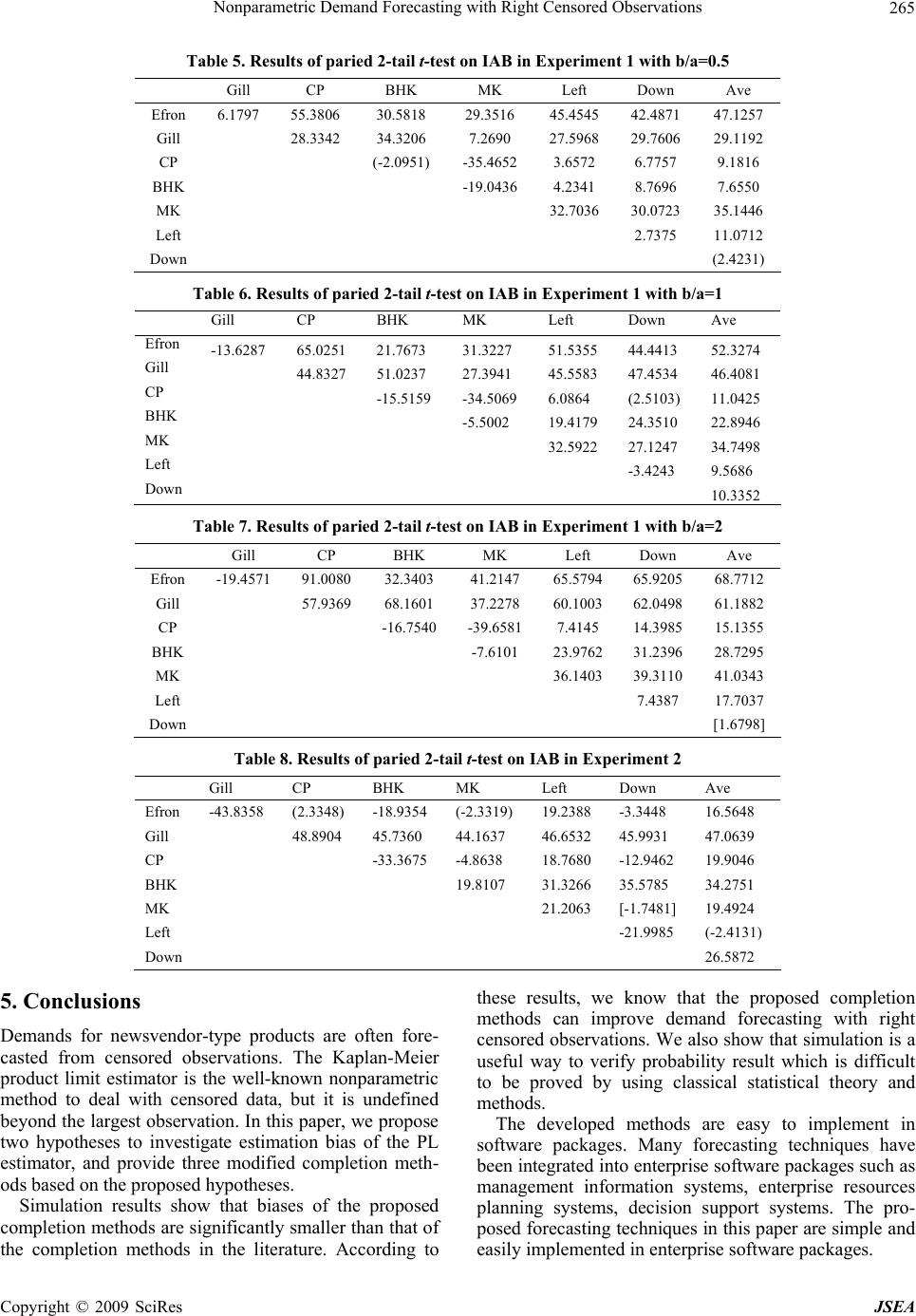 Nonparametric Demand Forecasting with Right Censored Observations 265 Table 5. Results of paried 2-tail t-test on IAB in Experiment 1 with b/a=0.5 Gill CP BHK MK Left Down Ave Efron 6.1797 55.3806 30.5818 29.3516 45.4545 42.4871 47.1257 Gill 28.3342 34.3206 7.2690 27.5968 29.7606 29.1192 CP (-2.0951) -35.4652 3.6572 6.7757 9.1816 BHK -19.0436 4.2341 8.7696 7.6550 MK 32.7036 30.0723 35.1446 Left 2.7375 11.0712 Down (2.4231) Table 6. Results of paried 2-tail t-test on IAB in Experiment 1 with b/a=1 Gill CP BHK MK Left Down Ave Efron -13.6287 65.0251 21.7673 31.3227 51.5355 44.4413 52.3274 Gill 44.8327 51.0237 27.3941 45.5583 47.4534 46.4081 CP -15.5159 -34.5069 6.0864 (2.5103) 11.0425 BHK -5.5002 19.4179 24.3510 22.8946 MK 32.5922 27.1247 34.7498 Left -3.4243 9.5686 Down 10.3352 Table 7. Results of paried 2-tail t-test on IAB in Experiment 1 with b/a=2 Gill CP BHK MK Left Down Ave Efron -19.4571 91.0080 32.3403 41.2147 65.5794 65.9205 68.7712 Gill 57.9369 68.1601 37.2278 60.1003 62.0498 61.1882 CP -16.7540 -39.6581 7.4145 14.3985 15.1355 BHK -7.6101 23.9762 31.2396 28.7295 MK 36.1403 39.3110 41.0343 Left 7.4387 17.7037 Down [1.6798] Table 8. Results of paried 2-tail t-test on IAB in Experiment 2 Gill CP BHK MK Left Down Ave Efron -43.8358 (2.3348) -18.9354 (-2.3319) 19.2388 -3.3448 16.5648 Gill 48.8904 45.7360 44.1637 46.6532 45.9931 47.0639 CP -33.3675 -4.8638 18.7680 -12.9462 19.9046 BHK 19.8107 31.3266 35.5785 34.2751 MK 21.2063 [-1.7481] 19.4924 Left -21.9985 (-2.4131) Down 26.5872 5. Conclusions Demands for newsvendor-type products are often fore- casted from censored observations. The Kaplan-Meier product limit estimator is the well-known nonparametric method to deal with censored data, but it is undefined beyond the largest observation. In this paper, we propose two hypotheses to investigate estimation bias of the PL estimator, and provide three modified completion meth- ods based on the proposed hypotheses. Simulation results show that biases of the proposed completion methods are significantly smaller than that of the completion methods in the literature. According to these results, we know that the proposed completion methods can improve demand forecasting with right censored observations. We also show that simulation is a useful way to verify probability result which is difficult to be proved by using classical statistical theory and methods. The developed methods are easy to implement in software packages. Many forecasting techniques have been integrated into enterprise software packages such as management information systems, enterprise resources planning systems, decision support systems. The pro- posed forecasting techniques in this paper are simple and easily implemented in enterprise software packages. Copyright © 2009 SciRes JSEA 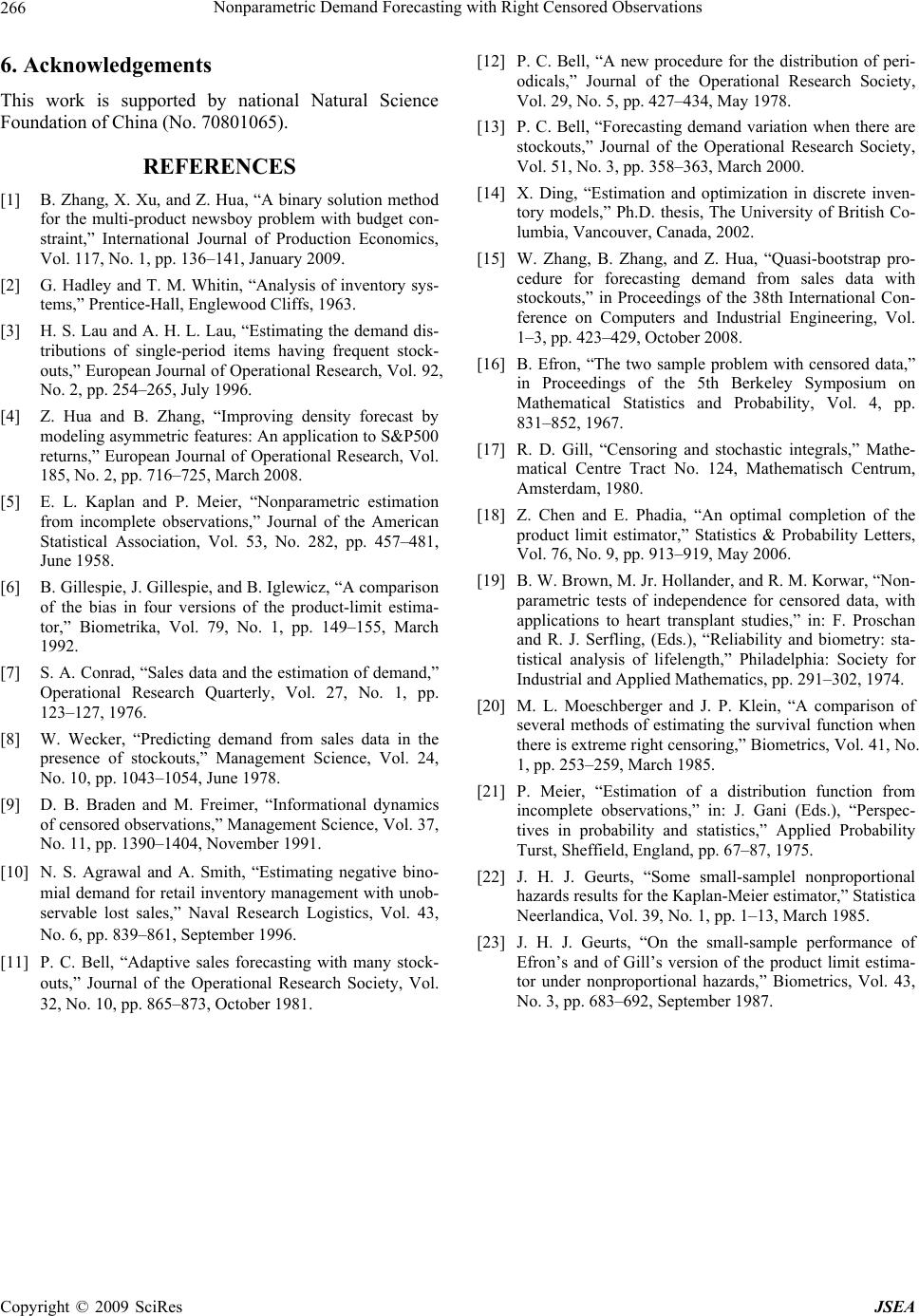 Nonparametric Demand Forecasting with Right Censored Observations 266 6. Acknowledgements This work is supported by national Natural Science Foundation of China (No. 70801065). REFERENCES [1] B. Zhang, X. Xu, and Z. Hua, “A binary solution method for the multi-product newsboy problem with budget con- straint,” International Journal of Production Economics, Vol. 117, No. 1, pp. 136–141, January 2009. [2] G. Hadley and T. M. Whitin, “Analysis of inventory sys- tems,” Prentice-Hall, Englewood Cliffs, 1963. [3] H. S. Lau and A. H. L. Lau, “Estimating the demand dis- tributions of single-period items having frequent stock- outs,” European Journal of Operational Research, Vol. 92, No. 2, pp. 254–265, July 1996. [4] Z. Hua and B. Zhang, “Improving density forecast by modeling asymmetric features: An application to S&P500 returns,” European Journal of Operational Research, Vol. 185, No. 2, pp. 716–725, March 2008. [5] E. L. Kaplan and P. Meier, “Nonparametric estimation from incomplete observations,” Journal of the American Statistical Association, Vol. 53, No. 282, pp. 457–481, June 1958. [6] B. Gillespie, J. Gillespie, and B. Iglewicz, “A comparison of the bias in four versions of the product-limit estima- tor,” Biometrika, Vol. 79, No. 1, pp. 149–155, March 1992. [7] S. A. Conrad, “Sales data and the estimation of demand,” Operational Research Quarterly, Vol. 27, No. 1, pp. 123–127, 1976. [8] W. Wecker, “Predicting demand from sales data in the presence of stockouts,” Management Science, Vol. 24, No. 10, pp. 1043–1054, June 1978. [9] D. B. Braden and M. Freimer, “Informational dynamics of censored observations,” Management Science, Vol. 37, No. 11, pp. 1390–1404, November 1991. [10] N. S. Agrawal and A. Smith, “Estimating negative bino- mial demand for retail inventory management with unob- servable lost sales,” Naval Research Logistics, Vol. 43, No. 6, pp. 839–861, September 1996. [11] P. C. Bell, “Adaptive sales forecasting with many stock- outs,” Journal of the Operational Research Society, Vol. 32, No. 10, pp. 865–873, October 1981. [12] P. C. Bell, “A new procedure for the distribution of peri- odicals,” Journal of the Operational Research Society, Vol. 29, No. 5, pp. 427–434, May 1978. [13] P. C. Bell, “Forecasting demand variation when there are stockouts,” Journal of the Operational Research Society, Vol. 51, No. 3, pp. 358–363, March 2000. [14] X. Ding, “Estimation and optimization in discrete inven- tory models,” Ph.D. thesis, The University of British Co- lumbia, Vancouver, Canada, 2002. [15] W. Zhang, B. Zhang, and Z. Hua, “Quasi-bootstrap pro- cedure for forecasting demand from sales data with stockouts,” in Proceedings of the 38th International Con- ference on Computers and Industrial Engineering, Vol. 1–3, pp. 423–429, October 2008. [16] B. Efron, “The two sample problem with censored data,” in Proceedings of the 5th Berkeley Symposium on Mathematical Statistics and Probability, Vol. 4, pp. 831–852, 1967. [17] R. D. Gill, “Censoring and stochastic integrals,” Mathe- matical Centre Tract No. 124, Mathematisch Centrum, Amsterdam, 1980. [18] Z. Chen and E. Phadia, “An optimal completion of the product limit estimator,” Statistics & Probability Letters, Vol. 76, No. 9, pp. 913–919, May 2006. [19] B. W. Brown, M. Jr. Hollander, and R. M. Korwar, “Non- parametric tests of independence for censored data, with applications to heart transplant studies,” in: F. Proschan and R. J. Serfling, (Eds.), “Reliability and biometry: sta- tistical analysis of lifelength,” Philadelphia: Society for Industrial and Applied Mathematics, pp. 291–302, 1974. [20] M. L. Moeschberger and J. P. Klein, “A comparison of several methods of estimating the survival function when there is extreme right censoring,” Biometrics, Vol. 41, No. 1, pp. 253–259, March 1985. [21] P. Meier, “Estimation of a distribution function from incomplete observations,” in: J. Gani (Eds.), “Perspec- tives in probability and statistics,” Applied Probability Turst, Sheffield, England, pp. 67–87, 1975. [22] J. H. J. Geurts, “Some small-samplel nonproportional hazards results for the Kaplan-Meier estimator,” Statistica Neerlandica, Vol. 39, No. 1, pp. 1–13, March 1985. [23] J. H. J. Geurts, “On the small-sample performance of Efron’s and of Gill’s version of the product limit estima- tor under nonproportional hazards,” Biometrics, Vol. 43, No. 3, pp. 683–692, September 1987. Copyright © 2009 SciRes JSEA |

